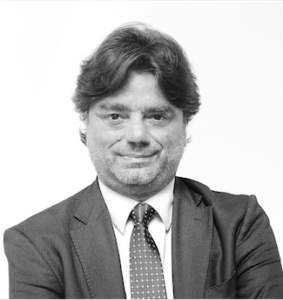Economic concerns have not dampened Italy’s drive to meet its environmental targets. Reportedly, the country’s integrated efforts to promote sustainable practices across the value chain have impacted consumer behaviour and building practices. How are HVACR manufacturers coping with the resulting trends, and what are the implications for Brand Italy in the global market? Hannah Jo Uy has the story…

Mauro Montello
Italy, being a member state of the European Union, is under the same pressure to meet environmental objectives. However, unlike its neighbouring countries, Italy is also in the process of strengthening its economy, which remarkably faltered during the turbulence Europe witnessed till not so long ago. “There are positive signs of recovery,” says Mauro Montello, General Manager, Sales & Marketing, Mitsubishi Electric Hydronics & IT Cooling Systems, “but because [the impact of the crisis] is clearly visible in the construction market, which was one of the most affected, more time is needed.”

Andrea Salcone
Andrea Salcone, Engineer, DESIGN? Studio, based in Italy, echoes this. “The construction of new buildings has suffered a huge reduction over the recent years due to the economic crisis,” he says. “However, restoration of existing estates has become increasingly relevant, thanks to government subsidies for energy redevelopment works.” Additionally, Salcone says, consumer demand for energy-efficient homes is growing.
 Andrea Guderzo, General Manager, Clivet Mideast & Africa, speaks on how the experience developed greater resilience in companies that were able to survive the period of economic uncertainty. “Uneven supply and demand in the market made us even more focused on both market needs and technological research,” he says. “This resulted in innovative solutions and strengthened our system approach to solve at once the most requirements with minimum energy input and at an effective capital cost.”
Andrea Guderzo, General Manager, Clivet Mideast & Africa, speaks on how the experience developed greater resilience in companies that were able to survive the period of economic uncertainty. “Uneven supply and demand in the market made us even more focused on both market needs and technological research,” he says. “This resulted in innovative solutions and strengthened our system approach to solve at once the most requirements with minimum energy input and at an effective capital cost.”

Gianpaolo Bruno
As manufacturers navigate the economic climate, concerns for the literal climate are also being emphasised by a government that is showing no signs of resting on its laurels when it comes to developing a sustainable framework. Gianpaolo Bruno, Italian Trade Commissioner to the UAE, Oman and Pakistan, says that energy efficiency is one of the main priorities of the government and the business community as a whole. This, he says, is due to the fact that the country is a major importer of energy products. “Most importantly,” he says, “Italy would like to reach its energy-efficiency targets, vis-à-vis EU strategy.”
Bruno asserts that legislation is helping stakeholders move forward in this regard. “In recent years,” he says, “there is a fully fledged set of regulations compliant with EU directives to grant energy-saving targets and energy-saving requirements in all private and public establishments.”
Since January 2018, Salcone says, all new constructions must cover at least the 50% of the on-site energy requirements with renewable energy and must demonstrate an even lower energy consumption for their standard use. “This is only the current step in a process that began about 10 years ago,” he says, “and should lead to Nearly Zero Energy Buildings (nZEB) as a standard for new constructions, in the near future.”
Additionally, to further enhance energy efficiency in buildings developments, Salcone says, the government provided incentives, such as tax refunds or investment reimbursements up to 65% of the total cost of the works. “All these have pushed stakeholders in the construction industry towards more energy-efficient practices,” he says.

Francesco Mastrapasqua
As far as HVACR fittings are concerned, Bruno says, constant maintenance is mandatory. “Every year, maintenance is required for all equipment in private and public buildings,” he says. “This includes both heating and air conditioning systems. Each apartment owner has to have a booklet, where the company that performs the maintenance, records the KPIs of the equipment.” Bruno adds that maintenance companies, in turn, have to be fully compliant with legislation. “They have to be listed as official maintenance companies, and they need to go and check the equipment in terms of both the security and [overall] energy efficiency in the buildings,” he says.
Providing a perspective with regard to refrigerants, Francesco Mastrapasqua, Marketing Manager-Refrigeration Systems, EPTA, says that he has observed a shift towards sustainable natural solutions across Europe as a whole, driven by both a sense of social responsibility towards the environment and the F-Gas regulation, which was enforced in 2015. “This year, in particular,” he says, “the second step in the reduction of fluorinated gases, in force since January 1, 2018, accelerates the process of phasing out HFCs, targeting 37% below the 2015 levels.”
Compliance
To ensure compliance, the regulations being rolled out by the government are complemented by a strong follow-up mechanism. Big fines and public liabilities, Bruno says, are imposed on “apartment owners, maintenance companies and condominium boards of the buildings that have climate control equipment” that do not comply.
This has had a number of implications in the real estate market. “Energy labelling of real estates is slowly getting more attention from buyers,” Salcone says, “and, although not as quickly as the energy labelling of home appliances, it is gradually becoming more and more relevant in the selection process.”
“When you buy a new apartment,” Bruno says, “these apartments are rated as far as energy efficiency, and this is reflected in the price you pay–the more compliant you are, the higher the price.” The energy-efficiency rating helps put a premium on real estate properties that have invested in such systems. This not only justifies the cost and drives demand for more efficient equipment, but it also showcases the environmental consciousness that exists among the people.
Salcone says that people are more willing to pay a little more for the house if they are aware that the extra cost will be recovered and will lead to savings during the lifecycle of the house, “which is very long in Italy – over 40-50 years”.
Environmental concern and compliance, Bruno emphasises, is widespread and well-rooted among the people. “There is a strong sensitivity among the population,” he says. “In schools, pupils are taught how to be environmentally friendly and so to save on energy.” Consumers recognise the value of energy efficiency with the view of reducing consumption of electricity, which traditionally comes at a high cost. “People feel that they have to contribute to the sustainability [agenda] both in the aspect of saving on energy bills and environmental cost,” he says.
Resulting trends
The assertive role that regulation plays has developed trends in the market that manufacturers must cope with. Bruno says the stringent regulations led to a highly competitive environment, where manufacturers have to step up. “Companies are very aware of [the importance] of respecting the regulations as far as energy efficiency and security norms are concerned,” he says. “[As such,] there is strong competition based on the equipment and energy-efficiency performance.”
Providing a manufacturer’s perspective, Guderzo says that EU energy regulations and real estate dynamics have led to “high efficiency requirements at a sustainable cost of ownership”, and that he considers the new Energy-related Products (ErP) requirements as the strongest driver within the industry.
Montello says that certifications are becoming more common in Italy, as energy-efficiency targets are being consolidated in buildings as well as in plants. “Green labelling is imposing higher efficiency standards,” he says, “and the market must, therefore, come to terms with the new tiers.” Montello says that though the company has always aimed to be energy efficient by offering three levels of efficiency in its product range, recent trends have prompted the company to differentiate its offering in three segments – comfort, process and IT-cooling – to better respond to emerging needs.
Citing trends in the market, Montello says he has seen an uptake in “the use of the inverter at partial loads to increase energy efficiency, four-pipe systems that allow simultaneous production of heating and cooling and in the installation of heat-recovery units”.
Sharing a similar observation with regard to growing demand for products with high seasonal efficiency and the value of a specialised system approach for energy conservation, Guderzo says the new trend confirmed the company’s decision to evolve its designs. “Thanks to optimal part-load performance,” he says, “inverter-driven and multi-scroll technologies are the core engine for our residential and commercial solutions.”
Salcone further elaborates on trends within the residential developments based on projects he has seen, noting that the sector is mainly focused on radiant floors for heating and, most frequently, inverter-based split systems for air conditioning. Additionally, he says, VRF technology is slowly becoming the standard choice for commercial buildings, especially in small- and medium-sized applications. “Although, recently,” he says, “the use of radiant floors is spreading along with the equipment that provides dehumidification and ventilation with heat recovery.” In view of this, Salcone says there has been an uptake for “all-in-one and split heat pump equipment”.
Salcone says that in the last few years, the move towards the integration of heat pump-based systems can particularly be felt in new constructions and in heavy restoration works. “This increase in circulation of heat pump systems, mainly air-to-air and air-to-water, comes together with a greater attention to energy efficiency in building design and HVAC systems, driven by the need to comply with EU and national regulations requiring even lower energy consumption,” he says.
Guderzo affirms the trend, saying that heat pump technology is also widely present in Clivet’s systems. “It is versatile, allows heating and cooling at once and can benefit from renewable energy,” he says. “Another important pillar is air purification: Dedicated outdoor air systems, complete with thermodynamic energy recovery, will have a dramatic potential in the coming years.” Guderzo adds that with air circulation responsible for 50% of the energy input year round, greater emphasis is being placed on airside products that are designed for efficiency and savings.
One size fits all?
Salcone, however, is quick to point out that in a country with such a diverse landscape, a one-size-fits-all approach is not effective. “Italy is a country with different types of construction techniques from north to south and from east to west,” he says. “It is also characterised by climatic conditions that can vary greatly between two places located less than 100 kilometres from each other. Therefore, there is no universally effective solution to be applied, and the designer must decide each time what would be the best system by examining the geographic location and by taking into account customer demand.”
From a manufacturer’s point of view, Guderzo says that “function diversity” is another popular European requirement and that there is growing demand for equipment to address a diverse spectrum of individual project requirements. The answer, he says, are standard systems designed to be versatile, specialised and factory-fitted to have the necessary functions and components that are reliable and require only minimum on-site work. Salcone also makes a case for the importance of flexibility in retrofit projects. “The need to comply with the most urgent energy standards set by law, together with the requirement to operate in a non-destructive approach on the buildings, makes retrofit projects much more complicated compared to others, in terms of design and development,” he says. “As a direct result, manufacturers of heating and cooling systems have made a huge effort to supply a wide range of products designed to provide a solution for almost all cases.”
Refrigerants
In terms of refrigerants, Mastrapasqua says there has been a steady move towards natural refrigerants, especially CO2 and propane. “We see a clear transition of the Retail, Ho.Re.Ca. and the Food & Beverage markets towards natural refrigeration, which has now become the reference solution adopted for new installations in Italy and in Europe,” he says.
EPTA, he says, has developed innovations and new technologies that are natural and environmentally friendly to comply with the stringent F-Gas regulation and with the Kigali amendment. The same goes for HVAC manufacturers, with Guderzo saying that exploring environmentally friendly refrigerants is another sensitive issue Clivet is focusing on, especially “reducing the content per unit and developing low-GWP solutions”.
Providing a perspective on commercial refrigeration, Mastrapasqua says that the phase-down requirements have massive implications on R-404A, which is a popular refrigerant of choice in refrigeration equipment, in favour of eco-friendly green refrigerants like CO2 and hydrocarbons. “With more than 12,000 CO2 transcritical systems installed in Europe by all the producers,” he says, “the cost of the equipment has finally been optimised and does not differ dramatically anymore from the cost of the previous R-404A system.
Leveraging investments
As Italian manufacturers invest to accommodate emerging trends, a number of companies have leveraged on the new products being developed and capitalised on the manufacturing excellence associated with the country, by using it as a competitive advantage to increase penetration in foreign markets.
“The high cost of energy in Europe has, therefore, always pushed us to develop highly efficient products,” Montello says. “This also guides us in the development of products dedicated to other markets.”
Bruno adds: “All manufacturing and equipment bear this seal of quality associated with energy efficiency compliancy, so companies really think there is leverage to be more competitive in marketplaces outside the European Union.” Including the Middle East, he further adds.
Montello says that historically, the company has had a strong presence in the northern part of Europe as well as in China and India. “Our presence in the GCC [region] markets is recent and, therefore, has high development potential,” Montello says. “We now have exclusive products only in the markets, where there are productive plants, but more than 30% of the products that come from our factories are ‘special’ and, therefore, are created ad hoc for specific buildings and projects.”
Speaking for Clivet, Guderzo says the company has a strong focus on the Europe, the Middle East, India and Africa market (EMEIA). “Thanks to the alliance with Midea,” he says, “our brand is now virtually available, worldwide. We do believe demanding EU regulations will be influential on a global scale and give new opportunities to our technologies. With a clear vision of market needs, customisation comes from the industrial combination of standard modules and components, for superior reliability.”
Bruno, however, believes there is scope for improvement. “[Italian manufacturers] face unfair competition from countries that do not respect high environmental standards,” he says. As this is typically owing to the lower cost associated with such products, Bruno believes that there should be better acknowledgement on the premium consumers have to pay to purchase such equipment. “There is room for public policy to intervene,” he says, “in terms of educating people and driving their purchases towards equipment that are more environmentally friendly than other countries that do not comply with strict EU regulations.”
Gleaning from the practices in Italy, where policy has helped move people away from cost-centric thinking, Bruno says: “Consumers are well aware that they have no choice but to comply with higher standards, because they can perceive that their common action could have an impact in the overall environmental and sustainability [agenda] of the country. We sincerely hope this kind of sensitivity could be as spread in other countries, where cost of energy is so low that the environmental sensitivity is not so widespread.”
Additionally, Bruno believes that public policy has an important role to play and must intervene to encourage stakeholders to “strike a balance between the time constraint to finish projects, the quality of materials you have to use and the equipment you have to install to [meet] environmentally friendly objectives”.
It would seem that Brand Italy is not only capitalising on its technological innovations, it is also eagerly passing on its integrated approach towards sustainability to bring about change in the mindset and approach of stakeholders in the global market.
Copyright © 2006-2025 - CPI Industry. All rights reserved.